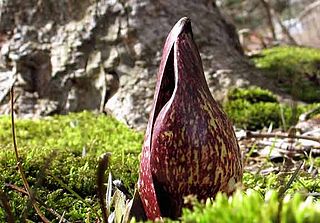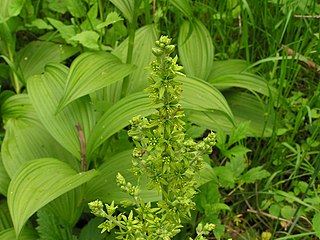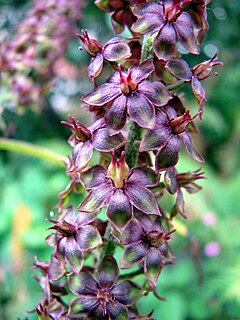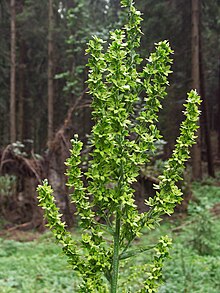
Melanthiaceae, also called the bunchflower family, is a family of flowering herbaceous perennial plants native to the Northern Hemisphere. Along with many other lilioid monocots, early authors considered members of this family to belong to the family Liliaceae, in part because both their sepals and petals closely resemble each other and are often large and showy like those of lilies, while some more recent taxonomists have placed them in a family Trilliaceae. The most authoritative modern treatment, however, the APG III system of 2009, places the family in the order Liliales, in the clade monocots. Circumscribed in this way, the family includes up to 17 genera.

Allium ursinum, known as wild garlic, wild cowleek, ramsons, buckrams, broad-leaved garlic, wood garlic, bear leek or bear's garlic, is a bulbous perennial flowering plant in the amaryllis family Amaryllidaceae. It is native to Europe and Asia, where it grows in moist woodland. It is a wild relative of onion and garlic, which belong to the same genus as wild garlic, Allium.

Melanthieae is a tribe of flowering plants within the family Melanthiaceae. Molecular phylogenetic studies in the 21st century have resulted in a large-scale reassignment of many of its species to different genera; in particular the genus Zigadenus (deathcamases) has been restricted to a single species, Zigadenus glaberrimus. Plants contain alkaloids, making them unpalatable to grazing animals; many are very poisonous to both animals and humans.

Skunk cabbage is a common name for several plants and may refer to:

Veratrum viride, known as Indian poke, corn-lily, Indian hellebore, false hellebore, green false hellebore, or giant false-helleborine, is a species of Veratrum native to eastern and western North America. It is extremely toxic, and is considered a pest plant by farmers with livestock. The species has acquired a large number of other common names within its native range, including American false hellebore, American white hellebore, bear corn, big hellebore, corn lily, devils bite, duck retten, itch-weed, itchweed, poor Annie, blue hellebore and tickleweed.
False helleborine is a name is used in different parts of the world to describe several different plants of either the Orchid family or the Lily family.
White hellebore or white false hellebore is a common name for several plants and may refer to:

Veratridine is a steroidal alkaloid found in plants of the lily family, specifically the genera Veratrum and Schoenocaulon. Upon absorption through the skin or mucous membranes, it acts as a neurotoxin by binding to and preventing the inactivation of voltage-gated sodium ion channels in heart, nerve, and skeletal muscle cell membranes. Veratridine increases nerve excitability and intracellular Ca2+ concentrations.

Jervine is a steroidal alkaloid with molecular formula C27H39NO3 which is derived from the plant genus Veratrum. Similar to cyclopamine, which also occurs in the genus Veratrum, it is a teratogen implicated in birth defects when consumed by animals during a certain period of their gestation.

Veratrum is a genus of flowering plants in the family Melanthiaceae. It occurs in damp habitats across much of temperate and subarctic Europe, Asia, and North America.
Sneezing powder is a group of powders or powder-like substances that induce sneezing when someone is exposed to them. This is usually done as a practical joke or prank to an unsuspecting victim.

Veratrum album, the false helleborine, white hellebore, European white hellebore, or white veratrum is a poisonous plant in the family Melanthiaceae. It is native to Europe and parts of western Asia.

Veratrum nigrum, the black false hellebore, is a widespread Eurasian species of perennial flowering plant in the family Melanthiaceae. Despite its common name, V. nigrum is not closely related to the true hellebores, nor does it resemble them.

Veratrum californicum is an extremely poisonous plant native to mountain meadows at 3500 to 11,000 ft elevation in southwestern North America, the Sierra Nevada and Rocky Mountains, and as far north as Alaska and as far south as Durango. It grows 1 to 2 meters tall, with an erect, unbranched, heavily leafy stem resembling a cornstalk. It prefers quite moist soil, and can cover large areas in dense stands near streams or in wet meadows. Many inch-wide flowers cluster along the often-branched top of the stout stem; they have 6 white tepals, a green center, 6 stamens, and a 3-branched pistil. The buds are tight green spheres. The heavily veined, bright green leaves can be more than a foot long.
Veratrum insolitum is a species of false hellebore, a type of plant closely related to the lily. Its common name is Siskiyou false hellebore. It is native to the northwestern United States: Washington, western Oregon, and northwestern California as far south as Trinity County.

Melanthium is a genus of herbaceous perennial plants native to North America. They are closely related to Veratrum, and in fact are included in that genus by some authors. The distinction between Melanthium and Veratrum is based on various morphological traits, but it is not yet clear where the line is best drawn.

Veratrum hybridum is a species of flowering plant in the Melanthiaceae known by the common names slender bunchflower and crisped bunchflower. Many publications use the synonyms Melanthium latifolium and Veratrum latifolium, but the "hybridum" epithet is 9 years older than the "latifolium," so Veratrum hybridum is now the accepted name.

Steroidal alkaloids have organic ring backbones which feature nitrogen-based functional groups. More specifically, they are distinguished by their tetracyclic cyclopentanophenanthrene backbone that marks their close relationship with sterols. They fall in two major categories: Solanum alkaloids and Veratrum alkaloids. A Steroidal alkaloid has also been found in Chonemorpha fragrans, 'chonemorphine' was used to treat intestinal infections in Wistar rats..
Melanthium woodii, common names Wood's bunchflower or Ozark bunch-flower, is a species formerly known as Veratrum woodii. It is native to the central and southeastern parts of the United States, from Arkansas, Florida, Georgia, Illinois, Indiana, Iowa, Kentucky, Missouri, North Carolina, Ohio, Oklahoma and Tennessee. It can be found in forested areas at elevations less than 800 m.













